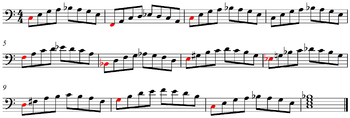
In music, a rewrite rule is a recursive generative grammar, which creates a chord progression from another.
Steedman (1984) has proposed a set of recursive "rewrite rules" which generate all well-formed transformations of jazz, basic I–IV–I–V–I twelve-bar blues chord sequences, and, slightly modified, non-twelve-bar blues I–IV–V sequences ("rhythm changes").
The typical 12-bar blues progression can be notated
1 2 3 4 5 6 7 8 9 10 11 12 I / I / I / I // IV /IV / I / I // V / IV / I / I
where the top line numbers each bar, one slash indicates a bar line, two indicate both a bar line and a phrase ending and a Roman numeral indicates the chord function.
Important transformations include

- replacement or substitution of a chord by its dominant or subdominant:
1 2 3 4 5 6 7 8 9 10 11 12 I / IV / I / I // IV / VII / III / VI // II / V / I / I //

- use of chromatic passing chords:
...7 8 9 ... ...III / ♭III / II...
- and chord alterations such as minor chords, diminished sevenths, etc.
Sequences by fourth, rather than fifth, include Jimi Hendrix's version of "Hey Joe" and Deep Purple's "Hush":
1 2 3 4 5 6 7 8 9 10 11 12 ♭VI, ♭III / ♭VII, IV / I / I // ♭VI, ♭III / ♭VII, IV / I / I // ♭VI, ♭III / ♭VII, IV / I / I //
These often result in Aeolian harmony and lack perfect cadences (V–I). Middleton (1990) suggests that both modal and fourth-oriented structures, rather than being, "distortions or surface transformations of Schenker's favoured V-I kernel, are more likely branches of a deeper principle, that of tonic/not-tonic differentiation."
For the ♭ notation, see Borrowed chord.
References
- Steedman M.J., "A Generative Grammar for Jazz Chord Sequences", Music Perception 2 (1) (1984) 52–77.
- Middleton, Richard (1990). Studying Popular Music, p.198. ISBN 0-335-15275-9.
| Chord progressions | |||||
|---|---|---|---|---|---|
| Terminology | |||||
| By number of chords |
| ||||
| By name | |||||
| Related | |||||
| List of chord progressions | |||||